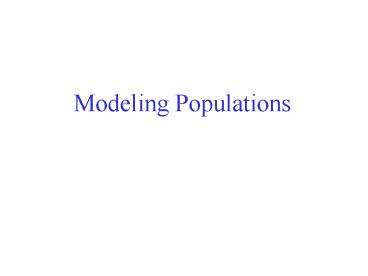Modeling Populations - PowerPoint PPT Presentation
1 / 18
Title:
Modeling Populations
Description:
Involves knowledge about birth and death rates, food supplies, social ... graduating in 1788, and became a curate near his family home in Surrey (Winch, 1989) ... – PowerPoint PPT presentation
Number of Views:22
Avg rating:3.0/5.0
Title: Modeling Populations
1
Modeling Populations
2
Population Dynamics
- Studies how populations change over time
- Involves knowledge about birth and death rates,
food supplies, social behaviors, genetics,
interaction of species with their environments
and interaction among themselves. - Models should reflect biological reality,
yet be simple enough that insight may be
gained into the population being studied.
3
Types of Models
- We will study the development of some basic
one- and two-species population models. - Malthusian (exponential) growth human
populations - Logistics growth human populations and yeast
cell growth - Logistics growth with harvesting.
- Predator-Prey interaction two fish populations
4
Malthus Model for Population Growth
- Thomas Malthus
5
Brief Biography
- Thomas Robert Malthus (he went by Robert) was
born on February 13, 1766. He was the second son
and sixth child of Daniel Malthus, a country
gentleman. Malthus was educated at Cambridge in
mathematics. He became an ordained minister
immediately after graduating in 1788, and became
a curate near his family home in Surrey (Winch,
1989).
6
Malthus Basic Idea
- Thomas Malthus (1766 - 1834) was a British
economist who startled early 19th century society
with his pessimistic prediction that population
growth would exceed food supply. Mankind would
sink into deep misery. Thomas Malthus on the
other hand focused on the interdependence between
poverty and population growth.
7
A Pessimistic View
- He took the pessimistic view that population
tends to expand faster than the food supply. - Malthus was an English Anglican clergyman who
devised and published his ideas on population in
the 1790s. Many had hoped that the French
Revolution and the Enlightenment would lead to a
new age of rational improvement in peoples'
lives. Malthus, an old Tory, argued instead that
it was ultimately going to be impossible to bring
about permanent improvement in the quality of
life.
8
Principle of Population
- In 1798 Malthus produced his famous essay,
Principle of the Population - A link to the above essay sis found here
http//www.ac.wwu.edu/stephan/malthus/malthus.0.h
tml - It details a pessimistic view of times to come
and offered as valuable reading material for such
people as Karl Marx and Charles Darwin, both
famous for their views on population
9
Principle of Population
- In his famous Essay on the Principle of
Population (1798), Malthus expressed the view
that famine and poverty were natural outcomes of
population growth. - The increase of population will take place, if
unchecked, in a geometrical progression, while
the means of subsistence will increase in only an
arithmetical progression. - Geometrical 2-4-6-8--2k
- Arithmetical 2-3-4-5-1k
- Population will always expand to the limit of
subsistence and will be held there by famine, war
and ill health. Later he added moral restraint,
as well. - That pessimistic view was not popular among
social reformers who were optimists, predicting
an everlasting economic growth.
10
(No Transcript)
11
The Malthus Model
- His model was based on the observation that the
time required for human popu-lations to double
was essentially constant (about 25 years at the
time), regardless of the initial population size.
12
US Population 1650-1800
- Data for U.S. population probably available to
Malthus. - The nearly-linear character of the right graph
indicates good agreement after 1700 with the
"uninhibited growth" model he produced.
13
Governing Principle
To develop a mathematical model, we formulate
Malthus observation as the governing principle
for our model Populations appeared to increase
by a fixed proportion over a given period of
time, and that, in the absence of constraints,
this proportion is not affected by the size of
the population.
14
Discrete-in-time Model
- t0, t1, t2, , tN equally-spaced times at which
the population is determined ?t ti1 - ti - P0, P1, P2, , PN corresponding populations at
times t0, t1, t2, , tN - b and d birth and death rates r b d, is the
effective growth rate. - P0 P1 P2
PN - ----------------------------------
-----gt t - t0 t1 t2
tN
15
The Malthus Model
Mathematical Equation (Pi 1 - Pi) / Pi
r ?t r b - d or Pi 1 Pi
r ?t Pi ti1 ti dt i 0, 1, ... The
initial population, P0, is given at the initial
time, t0.
16
An Example
Example Let t0 1900, P0 76.2 million (US
population in 1900) and r 0.013 (1.3
per-capita growth rate per year). Determine the
population at the end of 1, 2, and 3 years,
assuming the time step ?t 1 year.
17
Example Calculation
P0 76.2 t0 1900 ?t 1 r 0.013 P1 P0
r ?t P0 76.2 0.013176.2 77.3 t1
t0 ?t 1900 1 1901 P2 P1 r ?t P1
77.3 0.013177.3 78.3 t2 t1 ?t 1901
1 1902 ... P2000
277.3 (281.4), t2000 2000
18
National Censuses, 19002000 Year
Population Area-sq mi Pop.Per sq mi 1900
75,994,575 2,969,834 25.6 1910 91,972,266
2,969,565 31.0 1920 105,710,620 2,969,451
35.6 1930 122,775,046 2,977,128 41.2 1940
131,669,275 2,977,128 44.2 1950 150,697,361
2,974,726 50.7 1960 179,323,175 3,540,911
50.6 1970 203,302,031 3,540,023 57.4 1980
226,545,805 3,539,289 64.0 1990 248,709,873
3,536,278 70.3 2000 281,421,906 3,537,441 79.6 1
. Beginning with 1960, figures include Alaska and
Hawaii. 2. Excludes armed forces overseas.































